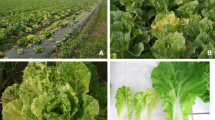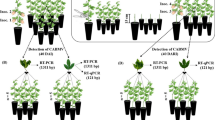Abstract
Indian citrus ringspot disease is an important viral disease in kinnow mandarin orchards where disease incidence up to 100% has been recorded. The disease is caused by Indian citrus ringspot virus (ICRSV), a positive sense flexuous RNA virus. The transmission of ICRSV is generally through budwood. Association of ICRSV with pollens of naturally infected flowers from cv. ‘Kinnow’ mandarins has been shown previously and this study demonstrates the presence of ICRSV in seed tissues. DAC-ELISA revealed the presence of virus in seed coats but not in embryo and endosperm of seeds collected from the fruits of ICRSV-infected Kinnow plants. Of the infected seed coats, 18% were found to harbor the virus. The seedlings in the grow-out test did not show any symptom for 2 years and the virus could not be detected in seedlings by DAC-ELISA and RT-PCR. The present study indicated that ICRSV could be localized in the testa of seeds but its transmission to progeny was not observed.

Similar content being viewed by others
References
Ahlawat, Y. S., & Pant, R. P. (2003). Major viruses and virus like diseases of citrus in India, their diagnosis and management. Annual Review of Plant Pathology, 2, 447–474.
Albrechtsen, S. E. (2006). Testing methods for seed transmitted viruses: Principles and protocols. Wallingford, UK: CABI Publishing.
Amari, K., Burgos, L., Pallás, V., & Sánchez-Pina, M. A. (2007). Prunus necrotic ringspot virus early invasion and its effects on apricot pollen grain performance. Phytopathology, 97, 892–899.
Baranwal, V. K., Chakraborty, N. K., Giri, B. K., & Ahlawat, Y. S. (2000) Purification, production of polyclonal antibodies and detection of Indian citrusringspot virus (ICRSV) (pp. 1036–1040). Hitech citrus management: Proceedings of the International Symposium on Citriculture (1999, Nagpur, India).
Byadgi, A. S., & Ahlawat, Y. S. (1995). A new viral ringspot disease of citrus (Citrus species) in India. Indian Journal of Agricultural Sciences, 65, 61–68.
Castellano, M. A., de Stradis, A., Minafra, A., Boscia, D., & Martelli, G. P. (2009). Seed transmission of Fig latent virus 1. Journal of Plant Pathology, 91, 697–700.
Chalam, V. C., & Khetarpal, R. K. (2008). A critical appraisal of challenges in exclusion of plant viruses during trans-boundary movement of seeds. Indian Journal of Virology, 19, 139–149.
Conti, M. (2008). Seed transmission of plant viruses and diagnosis. Protezione delle Coiture, 1, 7–9.
Davino, M., Areddia, R., Pelicani, L., & Grimaldi, V. (1991). Indexing of seeds of different citrus species for tristeza and variegation viruses. Proceedings of the Eleventh Conference of the International Organization of Citrus Virologists (Orlando, FL, USA), pp. 368–372.
D’Onghia, A. M., Djelouah, K., & Savino, V. (2000). Serological detection of Citrus psorosis virus in seeds but not in seedlings of infected mandarin and sour orange. Journal of Plant Pathology, 82, 233–235.
Dulic-Markovic, I., & Rankovic, M. (1997). An experiment with plum pox virus transmission by apricot and peach seeds. Proceedings of Middle European Meeting ‘96 on Plum Pox (Budapest, Hungary, 1996), pp. 117–119.
Eynard, A., Roggero, P., Lenzi, R., Conti, M., & Milne, R. G. (1991). Test for pollen and seed transmission on Plum pox virus (Sharka) in two apricot cultivars. Advances in Horticultural Science, 5, 104–106.
Guerri, J., Pina, J. A., Vives, M. C., Navarro, L., & Moreno, P. (2004). Seed transmission of Citrus leaf blotch virus: Implications in quarantine and certification programs. Plant Disease, 88, 906.
Johansen, E., Edwards, M. C., & Hampton, R. O. (1994). Seed transmission of viruses: current perspectives. Annual Review of Phytopathology, 32, 363–386.
Martelli, G. P., Adams, M. J., Kreuze, J. F., & Dolja, V. V. (2007). Family Flexiviridae: a case study in virion and genome plasticity. Annual Review of Phytopathology, 45, 73–100.
Maule, A. J., & Wang, D. (1996). Seed transmission of plant viruses: a lesson in biological complexity. Trends in Microbiology, 4, 153–158.
Milusheva, S., Gercheva, P., Bozhkova, V., & Kamenova, I. (2008). Experiments on transmission of Plum pox virus through Prunus seeds. Journal of Plant Pathology, 90, S1.23–S1.26.
Mink, G. I. (1993). Pollen- and seed-transmitted viruses and viroids. Annual Review of Phytopathology, 31, 375–402.
Pant, R. P., & Ahlawat, Y. S. (1998). Partial characterization of a filamentous virus associated with ringspot disease of citrus. Indian Phytopathology, 51, 225–232.
Quainoo, A. K., Wetten, A. C., & Allainguillaume, J. (2008). Transmission of cocoa swollen shoot virus by seeds. Journal of Virological Methods, 150, 45–49.
Rumbou, A., Von Bargen, S., & Büttner, C. (2009). A model system for plant-virus interaction—infectivity and seed transmission of Cherry leaf roll virus (CLRV) in Arabidopsis thaliana. European Journal of Plant Pathology, 124, 527–532.
Rustici, G., Milne, R. G., & Accotto, G. P. (2002). Nucleotide sequence, genome organization and phylogenetic analysis of Indian citrus ringspot virus. Archives of Virology, 147, 2215–2224.
Schneider, H. (1968). The anatomy of citrus. In W. Reuther, L. D. Batchelor, & H. J. Webber (Eds.), The citrus industry, vol. 2 (pp. 1–85). Berkeley, CA, USA: University of California Press.
Stace-Smith, R., & Hamilton, R. (1988). Inoculum thresholds of seed borne pathogens: viruses. Phytopathology, 78, 875–880.
Tanner, J. D., Kunta, M., da Graca, J. V., Skaria, M., & Nelson, S. D. (2010). Evidence for citrus tatter leaf seed transmission in citrus. Citrus Research & Technology: XVIII Conference of the IOCV (Campinas (SP), Brazil), 31:50.
Tatineni, S., Shankar Sagaram, U., Gowda, S., Robertson, C. J., Dawson, W. O., Iwanami, T., et al. (2008). In planta distribution of ‘Candidatus Liberibacter asiaticus’ as revealed by polymerase chain reaction (PCR) and real-time PCR. Phytopathology, 98, 592–599.
Timmerman-Vaughan, G., Larsen, R., Murray, S., McPhe, K., & Coyne, C. (2009). Analysis of the accumulation of Pea enation mosaic virus genomes in seed tissues and lack of evidence for seed transmission in pea (Pisum sativum). Phytopathology, 99, 1281–1287.
Acknowledgments
The first author is grateful to the Indian Agricultural Research Institute for a Junior Research Fellowship. The authors are thankful to the Department of Biotechnology for financial support and to Dr. R. K. Jain, Head, Division of Plant Pathology, IARI, New Delhi, for the facilities.
Author information
Authors and Affiliations
Corresponding author
Rights and permissions
About this article
Cite this article
K., P., Baranwal, V.K. Indian citrus ringspot virus: localization of virus in seed tissues and evidence for lack of seed transmission. Phytoparasitica 39, 491–496 (2011). https://doi.org/10.1007/s12600-011-0181-5
Received:
Accepted:
Published:
Issue Date:
DOI: https://doi.org/10.1007/s12600-011-0181-5




